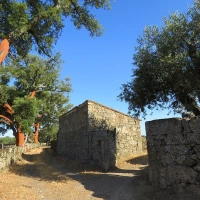The Sheikhs of Abu Dhabi
As one of the main tribes of the Arabian Peninsula, the Bani Yas tribal confederation is made up of several tribes. It is a common history rather than the ties of blood that tied them together. Originating in Nejd, the tribe moved south-east, and settled in the area between Doha and Buraimi. Not much is known about the early history of the tribe, as no written records were kept. It is said that they can trace their ancestry back to Yas bin Amir bin Sasa.
The settlement of the Bani Yas in the desert hinterland of Al Dhafrah marks the beginning of the Sheikhdom of Abu Dhabi. The earliest written reference to the Bani Yas is made in the Omani chronicle, Kashf al-Ghummah, which states that the Bani Yas tribes lived in the desert region east of Sabkhat Matti, between the Gulf Coast to the north and the Rub al-Khali to the south in the early 17th century.
With the progression of time, Liwa with its fertile land, sweet water wells and date palm groves, situated in the heartland of Al Dhafrah, became the historic home of the Bani Yas. This is where the only permanent settlements of the Bani Yas and Manasir, who inhabited the vast desert landscape of Al Dhafrah, could be found. There existed a strong bond between them, and although they lived in palm-frond houses, they also built forts for protection.
Even though the biggest portion of the Bani Yas tribe was composed of Bedouin who tended their herds of camels in the interior, some sections of the tribe frequented the coast and became fishermen. After the discovery of water on Abu Dhabi island, which at the time was known as Mleih, in 1761, sections of the Bani Yas tribe settled here permanently. It became the first permanent coastal settlement of the Bani Yas tribe that centred around fishing and pearling.
Sheikh Dhiyab bin Isa, who is credited with founding the town of Abu Dhabi, preferred to stay in the interior and deal with the internal disputes of the Al Bu Falah section of the Bani Yas tribe. During the final years of the 18th century, a section of the Al Bu Fallah under the leadership of Huzza bin Zayed in the coastal settlement of Abu Dhabi, stirred up turmoil and revolt against Sheikh Dhiyab. In 1793 Sheikh Dhiyab went to Abu Dhabi to order the family of Huzza and his dependents to leave the island and settle inland. Huzza, who at the time was in Bahrain, hastened back, and during an angry dispute managed to kill Sheikh Dhiyab.
This created a sharp division amongst the Bani Yas. One section supported Huzza, while the bigger section supported Sheikh Shakhbut bin Dhiyab (1793-1816), who, within two years managed to avenge his father’s killing. Following in his father’s footsteps, he managed to rise to a position of authority that provided leadership not just for the Al Bu Falah, but the Bani Yas tribe as a whole. Abu Dhabi witnessed rapid growth under the rule of Sheikh Shakhbut, and developed from an arid, uninhabited island to an inhabited settlement relying on the sea for food and income. With a new focus on fishing and pearling, sections of the Bani Yas also settled on Dalma island, and started to exploit other islands off the coast. During Sheikh Shakhbut’s reign Abu Dhabi became the seat of power for the Bani Yas. Despite this shift he realised that it was important to maintain the link between the coast and the hinterland, as it formed the basis for the livelihood of all the inhabitants, no matter which tribe they belonged to. During his rule, Sheikh Shakhbut managed to forged new alliances with other tribes and sub-sections of the Bani Yas, ensuring not only an increase in tax revenues, but also a bigger fighting force for the Sheikhdom. His policy of befriending the Bedouin tribes in the area paid off, as he could call on a few thousand excellent musketeers at any given time when needed. Sheikh Shakhbut realised the value of friendship, and did his best to stay on a good footing with all his neighbours, including the British, the Imam of Muscat, and the Qasimi Sheikh Sultan bin Saqr. When the Wahhabis made their presence felt in the region he maintained a policy of mutual tolerance without adopting their religious tenets or paying zakat.
In 1816 Sheikh Shakhbut was deposed by his eldest son Mohammed. After a brief two year rule, Sheikh Mohammed bin Shakhbut (1816-1818) was in turn deposed by his younger brother Sheikh Tahnun bin Shakhbut (1818-1833). Reputed as brave and liberal, he was described as very active with abundant vivacity, and a love of amusement, while he seemed to delight in warlike exercises. He was also feared by the people because of the despotic manner in which he ruled.
Upon Sheikh Tahnun’s assassination in 1833, Sheikh Khalifa bin Shakhbut (1833-1855), who was responsible for his brother’s death, and his brother Sultan bin Shakhbut ruled in partnership under the supervision of their father, but it quickly became clear that Sheikh Khalifa was the dominant leader. His rule was plagued by conspiracy, secession and war, and Sheikh Shakhbut engaged in various diplomatic overtures with the neighbouring powers on his son’s behalf. The British described him as a man of restless habits and an ambitious nature. At the end of 1844, the merchants on the Gulf Coast became rich, as a result of the successful pearl industry and trading voyages, while the Sheikhdom showed signs of prosperity. Under Sheikh Khalifa’s rule the Bani Yas developed into a fighting force that was highly respected throughout Al Dhafrah and the Trucial Coast. In July 1845 he was removed from power, as he, along with his brother Sheikh Sultan, fell victim to the revenge of Isa bin Khalid.
Abu Dhabi went through months of turmoil that was marked by revenge, after the assassinations of Sheikh Khalifa and his brother. Isa bin Khalid and Dhiyab bin Isa followed one another in quick succession as rulers, but met the same violent end. The bloodshed came to an end when Khalid bin Isa decided to leave Abu Dhabi with his friends of the Bu Muhair tribe under the command of Huzza bin Huzza. After Khalid left, his brother, with the help of some followers, tried to gain control over the Fort of Abu Dhabi, but Mohammed bin Humaid and Rashid bin Fadhil, two influential leaders of the Bani Yas, ejected them and took over the government on behalf of Sheikh Said bin Tahnun (1845-1855), who was residing in the interior at the time. Although he was only in his early twenties, he soon gained strength and influence over the tribes living in the area of Buraimi through his victory over the Wahhabis in the battle of Ankah. This made the neighbouring sheikhs of Dubai and Sharjah very nervous, especially as there were regular disputes between Abu Dhabi and Dubai, whose rulers both encouraged the seizure of slaves, pearls and stores from boats.
By 1855 Abu Dhabi was, once again, in the midst of a political crisis. The brother of Sheikh Said was murdered by a tribal elder in 1854 without any apparent reason. The Bani Yas sided with the elder though, and kept him under their protection, when Sheikh Said demanded his life. He eventually promised to forgive the murderer and forego blood money, but when the elder appeared before him, he killed him. This upset the tribe, and after barricading himself in the Fort for a while, he managed to escape, taking with him most of his property. Sheikh Said’s story to the British Resident painted a different picture, as he maintained that his efforts to catch the perpetrators of a maritime outrage, incensed his subjects so much that he was forced to leave the capital.
A short while afterwards, the elders sent for and handed the Fort over to Sheikh Zayed bin Khalifa (1855-1909), Sheikh Said’s first cousin. In July 1856 Sheikh Said made a bid to recapture his lost power by attacking and taking possession of a part of Abu Dhabi, while Sheikh Zayed was at his summer retreat in the Dhafrah. After collecting a force of 300 warriors, Sheikh Zayed surrounded the Muqta Bastion. In the ensuing battle Sheikh Said, together with his brother Hamdan bin Tahnun and Syed bin Mana, the ruler of Abu Hayle, and 45 others were killed. It is ironic that the life of this dynamic leader, who was known for his ability to successfully work out peace treaties and agreements, came to such a violent end.
The young Sheikh Zayed was a born leader, and it quickly became evident that he had a very strong character. He spent a lot of time with the Bedouin, learning their ways and methods of dealing with tribal questions, and in doing so, he unknowingly prepared himself for his role of leader of the Bani Yas. Even though Sheikh Zayed inherited a Sheikhdom that was prosperous and politically powerful, he had many difficult situations to deal with at the beginning of his reign, but his personality and leadership qualities impressed the British and won him the love and respect of his people. In 1880, Sheikh Zayed went on a pilgrimage to Mecca. The religious nature of the journey, as well as his absence from the political intrigues in the area, impacted on him in such a way that on his return, he did his utmost to steer away from conflicts, and to establish peace between adversaries. What distinguished Sheikh Zayed from other rulers was his unparalleled sense of forgiveness, kindness, and faithfulness. Tribal politics often necessitated various matrimonial alliances, and Sheikh Zayed, as a result, had more than one wife. His hospitality was typical of the Arab tradition. Visitors to Abu Dhabi, even in his absence, were provided with meals at his house.
The death of Sheikh Zayed in 1909 again led to a period of violence and political instability with a couple of frequent successions, until Sheikh Shakhbut bin Sultan (1928-1966) came to power in 1928. After Sheikh Zayed’s death on 19 May 1909, Khalifa, the oldest of his eight sons, was chosen to succeed his father, but he refused, as he enjoyed living a peaceful life away from active politics. Sheikh Zayed’s second son, Sheikh Tahnun bin Zayed (1909-1912), an invalid that lost most of the use of his lower limbs due to some form of paralysis, became the next ruler. Despite his brief reign, he was a good and respected Sheikh. Upon his death on 11 October 1912, his brother Hamdan bin Zayed (1912-1922) succeeded him. He was concerned with the economic well-being of his people, and in order to maintain peace in the area, he annually presented gifts and provisions to the Chiefs of the Manasir, who, in return, maintained the peace and security in the interior which enabled the Bani Yas to go pearling. His demand for more taxes in Abu Dhabi, on the other hand, offended his people, and eventually led to his assassination by his brother Sheikh Sultan bin Zayed (1922-1926), who maintained the he oppressed his family and inhabitants of Abu Dhabi. He, in return, met his end at the hands of his brother Sheikh Saqr bin Zayed (1926-1928), whose growing misunderstandings with the members of the royal family, led to his assassination in January 1928.
At the time of Sheikh Sultan’s death, his sons Shakhbut, Huzza, and Zayed were in Buraimi, while Khalid, who was with him at the time, got injured during the crisis. During their uncles reign, Shakhbut and Huzza, travelled from place to place in search of a safe haven, and included Dubai, Sharjah, Al Hasa, Wakrah, and Dalma Island. In January 1928 Sheikh Shakhbut bin Sultan became ruler of Abu Dhabi, and soon afterwards affairs appeared to have returned to normal. Sheikha Salamah bint Buti made her sons swear an oath that they will refrain from conspiracy, and that they will not resort to bloodshed to settle family disputes.
Sheikh Shakhbut, in his early twenties, inherited a deteriorating political and economic situation. He had a great sense of humour, was intelligent and charming, and was known for his hospitality. He was also afflicted with a great nostalgia for the traditional Arab way of life, amidst the enormous change the discovery of oil heralded. Sheikh Shakhbut was ill-equipped for the complicated contracts and agreements with legal tangles that marked the transition from simple, honourable, and straightforward dealing of a Bedouin society. His tightfistedness and suspicious nature were two traits that made him the object of dislike and criticism. As early as August 1959, with his Sheikhdom on the verge of unimaginable wealth, Sheikh Shakhbut harboured thoughts of abdication. Criticised for his miserliness and his obsession with amassing money, he ironically continued to live a simple life. His only known luxury was an air-conditioner in his bedroom which he seldom used.
His subjects grew tired of the perpetual poverty they lived in, especially when they saw how oil money started changing the lives of people in the Gulf. Unable to conform to the demands of a rapidly changing era, Sheikh Shakhbut, in 1966 handed over the reins to his youngest brother, Sheikh Zayed bin Sultan(1966-2004).
Sheikh Khalifa bin Zayed (2004-2022), oldest son of Sheikh Zayed, and the only son of Sheikha Hassa bint Mohammed bin Khalifa Al Nahyan, was born in 1948 in Al Muwaiji Fort in Al Ain, where Sheikh Zayed served as the Ruler’s Representative, until he took over the reins of the Sheikhdom in 1966. One of the priorities of Sheikh Zayed, who himself only received basic schooling in the principles of Islam from a local mu’allim (teacher of the Holy Quran), was that his sons received a comprehensive education. Educated mainly in Al Ain and at the Royal Military Academy at Sandhurst in the United Kingdom, Sheikh Khalifa started to shadow his father soon afterwards to learn the art of leadership and nuances of local politics. Groomed from an early age to take over the responsibilities of leadership from his father, he was appointed Ruler’s Representative in Abu Dhabi’s Eastern Region on September 18, 1966, at the age of 18, and named Crown Prince of Abu Dhabi on February 1, 1969. Sheikh Khalifa was married to Sheikha Shamsa, a member of the Mazrui tribe that is part of the Bani Yas confederation.
Sheikh Mohamed bin Zayed (2022- ), third son of Sheikh Zayed, became ruler on 14 May 2022, the day after his brother Sheikh Khalifa passed away.
# The dates in brackets is when the different sheikhs ruled.
## The sheikhs, who have ruled Abu Dhabi from the late 18th century until today are from the Al Bu Falah branch of the Bani Yas tribe. Nahyan is regarded as the ancestor of the Al Bu Falah, hence it is his name that functions as the family name of the tribe.









